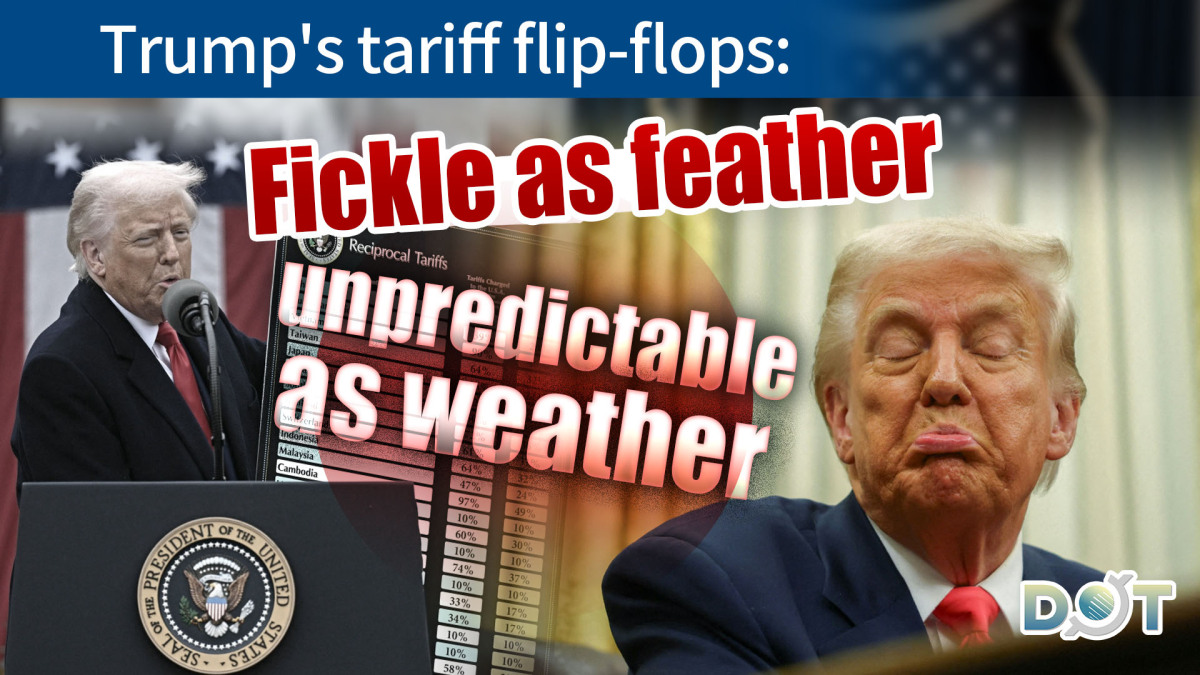
US President Donald Trump continues to push unilateralism and isolationism, igniting trade conflicts across the globe, with China as a primary target. Recently, the US announced a 34% "reciprocal tariff" on Chinese goods, prompting China to respond with a series of countermeasures. On April 7, Trump warned that unless China withdraws its retaliatory actions, the US would impose an additional 50% tariff on Chinese imports starting April 9 and terminate all Sino-US negotiations.
Although Trump appears resolute, his track record suggests otherwise. Throughout his two terms, he has frequently reversed his stance on tariff policies and trade agreements, leaving the longevity of these "sky-high tariffs" uncertain.
US-China trade war marked by flip-flops
In 2018, during his first term, Trump launched a trade war with China, imposing multiple rounds of tariffs on US$370 billion worth of Chinese goods, with rates as high as 25%. Despite expressing optimism during negotiations, Trump often reversed course, threatening to impose further tariffs.
In 2019, Trump claimed that trade talks were progressing rapidly and that US-China relations were strong. However, days later, he announced tariffs on an additional US$300 billion worth of Chinese imports.
In August 2019, the US Treasury officially labeled China a "currency manipulator." Yet, just months later, in January 2020, two days before signing the phase one trade deal, the designation was rescinded.
EU auto tariffs shelved indefinitely
In June 2018, Trump proposed a 25% tariff on EU automobiles and parts, citing "longstanding unfair trade practices." However, after meeting with European Commission President Jean-Claude Juncker in July, both sides agreed to suspend tariff threats and begin negotiations aimed at achieving "zero tariffs, zero barriers, and zero subsidies."
By May 2019, Trump postponed the decision to impose auto tariffs on the EU, granting a 180-day negotiation period. Despite continued threats, the tariffs were never implemented, primarily due to the onset of the COVID-19 pandemic and its economic impact.
Tariffs on Canada and Mexico delayed twice
In February this year, Trump announced nearly comprehensive tariffs on Canadian and Mexican imports starting February 1. However, after discussions with Canadian Prime Minister Justin Trudeau and Mexican President Claudia Sheinbaum, the tariffs were postponed for one month.
On March 4, the US implemented tariffs on Canadian and Mexican goods as scheduled, with Canada responding by imposing a 25% tariff on US$20.6 billion worth of US goods. Three weeks later, on March 6, Trump again delayed tariffs on goods covered under the United States–Mexico–Canada Agreement, extending the deadline to April 2. The move affected 50% of Mexican exports and 38% of Canadian exports.
Small parcel tariff policy reversed multiple times
On Feb. 1, Trump announced a 10% tariff on Chinese goods and removed the "de minimis exemption," which previously allowed goods valued under US$800 to enter the US duty-free. The US Postal Service (USPS) followed suit, halting acceptance of parcels from Chinese mainland and Hong Kong on Feb. 4.
However, within 12 hours, USPS reversed its decision and resumed accepting packages from Chinese mainland and HK starting Feb. 5. Days later, on Feb. 7, Trump signed an executive order delaying tariffs on small parcels from China and reinstating the previous exemption.
The abrupt policy changes exposed internal disarray and poor decision-making within the US administration.
Related News:
Trump to impose 104% tariffs on Chinese imports starting Wednesday
China's state-owned giants boost market confidence with buybacks and investment plans
Markets reel as new tariffs take effect: Crypto prices tumble




















Comment